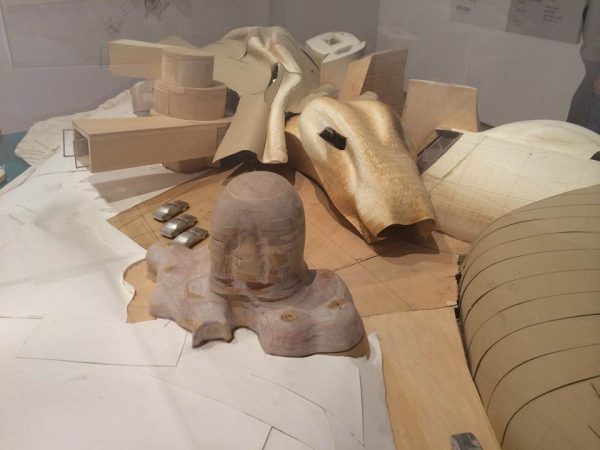The Haunted Horse Head and the Weathered Octopus

Allusive figuration is one of my pet theoretical issues, most recently played out in our design of the Boston Harbor Island Pavilion. The underlying principle is that ANY work of architecture that is inherently shapely (i.e. non-orthogonal) invites interpretation. The curved roofs of the pavilion were identified as two seagulls in flight, the carcass of a whale, and the structure of a boat during different stages of the public process. We worked hard not to accidentally back into a form that too literally referenced any one thing. Our goal to evade literal associations stands in marked contrast to Santiago Calatrava, who typically strives for a recognizable symbol that can help market the project. Calatrava’s swan in Milwaukee immediately comes to mind.
With this as a background, I was thrilled to run across a mid-career Frank Gehry project at the superb Archeology of the Digital exhibition at Yale. The show, focused on architectural projects that were conceived on the cusp of the digital revolution, highlights projects that anticipated the formal opportunities yielded by digital modeling in advance of the yet-to-be-realized efficiency of the tools. In my opinion, the projects benefited from the struggle between hand-drawn studies and primitive digital modeling. Maybe the shapes look great because they weren’t so easy to make (and thus had to be predetermined in terms of intention and form). The Lewis Residence, planned for a site in Lyndhurst, Ohio and designed by Gehry and his team between 1989 and 1995, is presented alongside Gehry’s more literalizing fish studies. Interestingly, the house includes two elements that fall squarely within my definition of an allusive symbol: a haunted horse head and a badly weathered octopus (my interpretation only). It is fascinating to see how the Gehry team negotiated between their experiments in digital modelling and the hard work of making the forms in paper and wood.
-Tim

